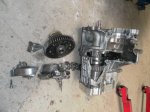This would be a VERY difficult guide to write and get right from the first draft.
Something that is not mentioned is weight transfer / preservation. By that I mean a RWD or AWD based on a RWD layout requires a good amount of weight transfer to get good traction off the line. Conversely a FWD or AWD based on a FWD layout requires weight preservation up front, or put another way it needs to resist weight transfer.
For weight transfer to happen, the rear shocks need to allow the car to squat and the front to lift / shocks extend but without lifting the front wheels off the ground. Maybe even preload the rear by having zero or even negative rake i.e. nose up slightly when stood on a level surface.
To preserve weight and resist transfer can be helped in several ways besides selective weight reduction or adding ballast. Adding rake (raising the rear or dropping the front) can really help as can shock setup. Setting the rear shocks to hard with maximum damping to resist squat and having the fronts sprung softer (less spring assistance when the front lifts) to keep the nose down all help to preserve weight over the front wheels.
To explain what I meant earlier by an AWD based on a RWD layout a typical example would be a Skyline GTR where the gearbox is in line driving the rear wheels and the transfer case throwing power forwards to the front wheels. An AWD based on a FWD layout would be along the lines of a GTO or EVO, transverse engine and gearbox where the front wheels are driven straight off the gearbox akin to a FWD; the transfer case (mounted on the side of the gearbox) throws some power towards the rear.
In the case of an AWD based around FWD weight transfer unloads the front wheels (primary driven wheels) which will spin like crazy. As the (typically) viscous diff struggles to lock up sending drive to the rears a huge load is placed on the transfer case which can fail quite spectacularly, as can things like UJ's and rear driveshafts depending on power levels. Even if there is no failure, there is a huge waste of power and traction. So you can see weight transfer / preservation is quite an important consideration.
This subject leads quite nicely onto alignment. Quite simply straight is fast! By that I mean that when you need the greatest traction (i.e. at launch) all wheels need to be as close to zero camber and zero toe as you can get them. This might require negative camber up front and positive camber at the rear to allow for lift at the front and squat at the rear. The amount will be determined by how much suspension movement you have on launching with your particular setup.
I hope people find this helpful and food for thought.
André









